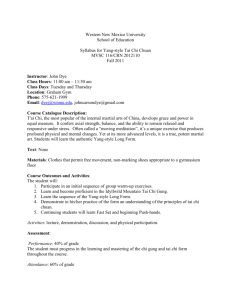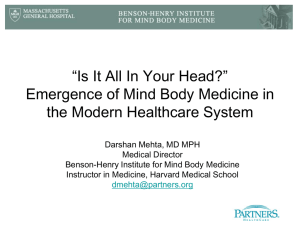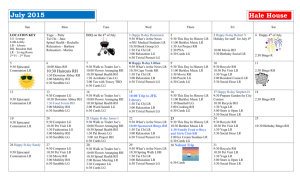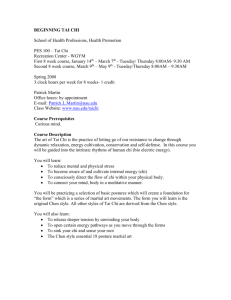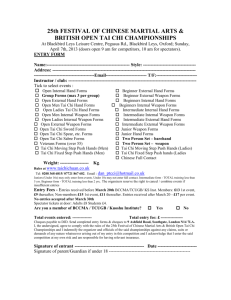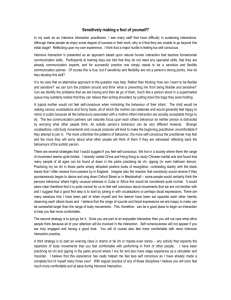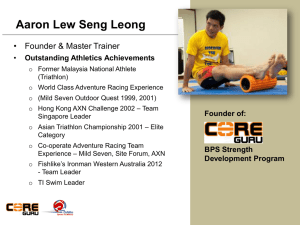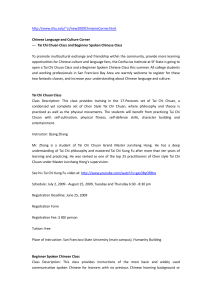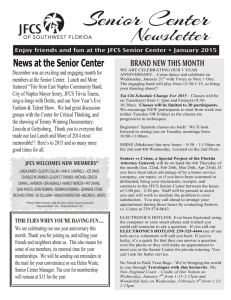演講投影片 - 勒星頓中文學校Lexington Chinese School
advertisement
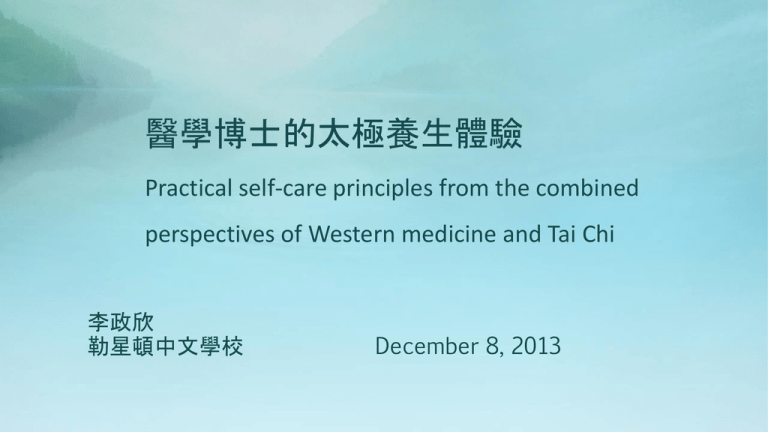
醫學博士的太極養生體驗 Practical self-care principles from the combined perspectives of Western medicine and Tai Chi 李政欣 勒星頓中文學校 December 8, 2013 何謂養生? • 古人云:善養生者,上養神智、中養形態、下養筋骨。 • 通過各種生活型態的調適, 颐養生命、增强體質、預防疾病, 以期儘量延長無(或少)病痛的時間, 並保持充分的心智與體 能, 而能完成各人生命中需要負擔的責任, 及希望達成的目 標. Common chronic conditions as we age• Musculoskeletal: osteoarthritis, gout, loss of muscle mass • Hormonal/metabolic: diabetes (type II), high cholesterol • Neurological: dementia, Parkinson’s disease, stroke, poor vision, hearing impairment, balance problem • Cardiovascular: heart attack, hypertension, heart failure, irregular heat beats, atherosclerosis • Cancers: colon, lung, prostate, breast, …etc • Lungs: chronic obstructive pulmonary disease, asthma • Urinary: incontinence, urgency • General: deconditioning, medication side effects, weight loss, falls Risk factors for cardiovascular diseases• • • • • • • • • High blood pressure High blood cholesterol Diabetes Smoking Being overweight Being physically inactive Having a family history of early heart disease Age (55 or older for women) Uncontrolled stress 癌變的過程 Source: http://www.medicinenet.com/ Early detectionCancer Screening 癌症篩檢 1. 乳癌- 乳房攝影檢查:45-69歲婦女、40-44歲二等親曾有乳癌家族史 之婦女,每2年1次。 2. 子宮頸癌- 抹片檢查:30歲以上婦女,每年1次,建議婦女們每3年至 少接受1次。 3.大腸癌- 糞便潛血檢查:50至未滿75歲民眾,每2年1次。大腸鏡:每10 年1次 4. 口腔黏膜檢查:30歲以上有嚼檳榔(含已戒檳榔)或吸菸者、18至未 滿30歲有嚼檳榔(含已戒檳榔)原住民,每2年1次。 5. 肝癌篩檢: 每6個月提供B肝帶原和慢性肝炎患者1次腹部超音波和甲型 胎兒蛋白檢查,可以降低37%的肝癌死亡率。 Scientific bases for self repair, healing and renewal: • DNA repair: defects associated with accelerated aging and increased risks of cancer • Adult stem cells • Immune surveillance Werner syndrome: a premature aging disorder caused by a genetic defect in DNA repair and replication How to prevent chronic conditions for a long, healthy, medically uncomplicated life• Healthy eating habits • Weight management • Physical exercise • Stress reduction • Psychosocial support • A good night’s sleep -Donald Levy, MD, Director of Osher Clinical Center for Complementary and Integrative Medical Therapies at Brigham and Women’s Hospital, quoted from The Harvard Medical School Guide to Tai Chi Healthy eating habits: • Balanced nutrition • Predominantly plant based, with high fiber content: choose whole grains and beans over processed white grains • Wide variety • Unprocessed food • Moderation: sugar, salt, red meat (saturated animal fat), cholesterol, alcohol, portion • Food safety: additives, preservatives, residual pesticides and herbicides, pollution (bio-concentration) • Slowing the pace of eating 維持適當的體重 Body Mass Index (BMI) Cutoff for Asians BMI Cutoff <18.5 Weight Status Comments Underweight Being underweight also puts you at risk for developing many health problems. Discuss with your healthcare provider about how to reach a healthy weight. Your weight is within normal range. You can continue to keep a 18.5 - 23.9 24 - 26.9 >27 Healthy weight healthy weight through physical activity and healthy eating. Keep range up with the good work! Overweight Being overweight can put you at risk for developing many chronic diseases. Discuss with your healthcare professional on how to achieve a healthy weight. Obese Obesity increases risks for developing many chronic diseases such as heart disease and diabetes, and decreases overall quality of life. Discuss with your healthcare provider about how to achieve a healthy weight! Wildman RP et al. Appropriate body mass index and waist circumference cutoffs for categorization of overweight and central adiposity among Chinese adults. American Journal of Clinical Nutrition 2004; 80:1129. Appropriate body-mass index for Asian populations and its implications for policy and intervention strategies. Lancet 2004; 363:157-63 Source: 加斯林美國亞裔糖尿病研進會(AADI) http://aadi.joslin.org/content/bmi-calculator 維持適當的腰圍 Target Waist Circumference for Asians and Asian Americans Sometimes even when your BMI is within normal range, having too much fat around the abdomen (Apple shape body) will still put you at risk for heart disease and diabetes. Below are the target goals for waist circumference measurements. Men Women Equals or less than 90cm (35.5 in) Equals or less than 80cm (31.5 in) Source: 加斯林美國亞裔糖尿病研進會(AADI) http://aadi.joslin.org/content/bmi-calculator Stress reduction• Stress: Body’s reaction to a challenge or threat • Fight-or-flight response: activation of the sympathetic nervous system - Blood pressure rises - Breathing becomes more rapid - Heart rate (pulse) rises - Muscles become tense - Digestive system slows down - Immune system goes down - Heightened state of alertness Medical conditions associated with chronic stress Between 60% and 90% of all physician visits are for stress-related complaints. - arrhythmias, hypertension, increased risk of heart attack and stroke - asthma - irritable bowel syndrome, ulcers - back pain, fatigue, headaches - suppression of the immune system, - increased vulnerability to anxiety and depression, infertility, and hastening the aging process, …etc Relaxation response (I)• a physical state of deep rest that changes the physical and emotional responses to stress (e.g., decreases in heart rate, blood pressure, rate of breathing, and muscle tension). • Can be elicited by two essential steps: - Repetition of a word, sound, phrase, prayer, or muscular activity. - Passive disregard of everyday thoughts that inevitably come to mind and the return to your repetition. from Benson Henry Institute for Mind Body Medicine at MGH Relaxation response (II)• Mind-body approaches that elicit the RR include: various forms of meditation, repetitive prayer, yoga, tai chi, breathing exercises, progressive muscle relaxation, biofeedback, guided imagery and Qi Gong. • Physiological effects of the RR: decreased oxygen consumption, decreased carbon dioxide elimination, reduced blood pressure, heart and respiration rate, …etc. Dusek et al, Genomic Counter-Stress Changes Induced by the Relaxation Response, PLoS ONE 2008 RR practice enhanced expression of genes associated with energy metabolism, mitochondrial function, insulin secretion and telomere maintenance, and reduced expression of genes linked to inflammatory response and stress-related pathways. -Dusek et al, PLoS ONE 2008; Bhasin et al, PLoS ONE 2013 Physical exercise• Moderate intensity: • 道家養生: 內丹: 靜功 (氣功); 動功 (內家拳: 太極拳, 八卦拳, 形意拳) • “Medicinal exercise”: 五禽戲, 八段錦, • Other mind body exercises: Yoga, Pilates, …etc. • 平甩功 Physical exercise- my Tai Chi regimen Daily (~40 min, outdoors) • 簡易氣功 • 太極熱身功 • 簡易太極32式 • 24式太極 Weekly (3-4 hr, indoors) • Basic exercise: stance work, waist turning, deep stretching • Meditation • 簡易太極32式 • 24式太極 • 太極刀 • 太極刀 • 楊式太極85式 • 推手 • 五禽戲, ... Health benefits of Tai Chi• Improve your balance and bones: flexibility, agility (一舉動, 周身俱要輕靈) • Ease your aches and pains: posture (虛領頂劲, 鬆肩, 含胸拔背; 立身中正而安舒), heightened body awareness, low impact • Strengthen your heart: aerobic, lower blood pressure • Deepen and enrich your breathing: 氣宜鼓盪, deep abdominal breathing • Sharpen your mind:神宜內斂, improve cognitive functions, learn new skills, coordination • Enhance psychological well being and sleep quality: stress reduction (meditation in motion), relaxation (神舒體靜), psychosocial support • Motivation and techniques to remain physically active for life from The Harvard Medical School Guide to Tai Chi, by Peter M. Wayne PhD with Mark L Fuerst A few more thoughts• Keep yourself well hydrated. • Kegel exercise: 提肛 • Allergy • Prevention of falls and injuries Acknowledgment Additional information sources- • 薛霖統先生 • http://www.humanmedia.org/ wellbeing/ • 黃修忻博士(Cecilia Wong, PhD) • http://www.massgeneral.org/b hi/ • 盧植生先生 • Anson Rathbone
